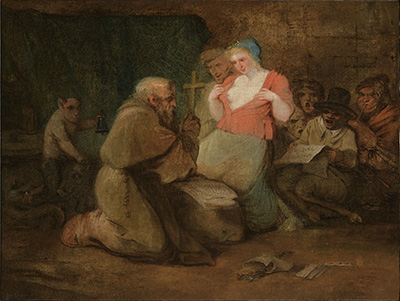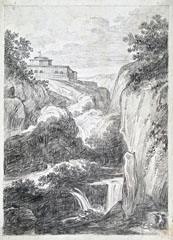(San Sebastiano Curone 1758 - Rome 1823)
LANDSCAPE WITH VILLA AND FOUNTAIN: VILLA MALTA IN ROME
Black chalk, on wove paper. 403 x 296 mm. Top right corner made up.
Giorgio Marini kindly pointed to me that the Villa portrayed in this drawing is Villa Malta, in Rome. From the second half of the eighteenth century Villa Malta became a point of support of the German community in Rome. In the early nineteenth century the villa was inhabited by the poetess Frederike Brun, and William von Humboldt, the ambassador to Rome of the King of Prussia; so that it became an intellectual center, frequented by the painters Camuccini, Koch and Angelica Kauffman and the sculptors Canova and Thorvaldsen. I link here an image of the Villa as painted by the Norwegian Johan Christian Clausen Dahl in 1821.
The drawing compares very well with the album, consisting of 22 sheets, preserved in the Biblioteca Civica, Forlì (Fondo Piancastelli). That album contains landscapes drawn by Giani on the Apennines, on the road going from Faenza to Marradi, traveled by him with a few friends in 1794. Those drawings, far from simple topography, transfigure the landscapes of the Apennines in the exaltation of the natural sublime. Our drawing is certainly to be dated to the same period, and probably represents other locations in the same area.
See Anna Ottani Cavina, Felice Giani 1758-1823 e la cultura di fine secolo, 1999, 2 volumes; volume 2, pp. 711-715, cat. no. A1.
Born near Genoa, Giani was trained first in Pavia then in Bologna, where he studied with Domenico Pedrini and Ubaldo Gandolfi. In 1780 he moved to Rome, studying with Pompeo Batoni, Giuseppe Antolini and Christoph Unterberger at the Accademia di San Luca and beginning his independent career as a fresco painter. He absorbed influences ranging from ancient Greek and Roman art to Michelangelo's and Raphael's Renaissance classicism and the Romantic classicism of contemporaries such as Johann Heinrich Fuseli. Between 1784 and 1794 he lived in Bologna and Faenza, executing decorative commissions. In 1803 he was summoned to Paris. Until the fall of Napoleon, Giani divided his time between Paris and Italy; then he successfully survived the political changes and continued to execute decorative schemes in Rome. Giani worked in a distinctive Neo-classical style, creating sumptuous, richly coloured rooms, the paintings on walls and ceilings being surrounded with a wealth of antique ornament. He was a prodigiously talented draughtsman, who drew constantly, both out of doors and in the studio.


